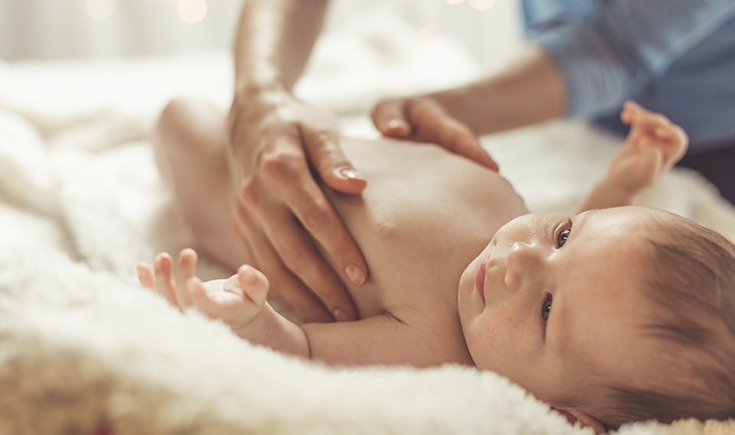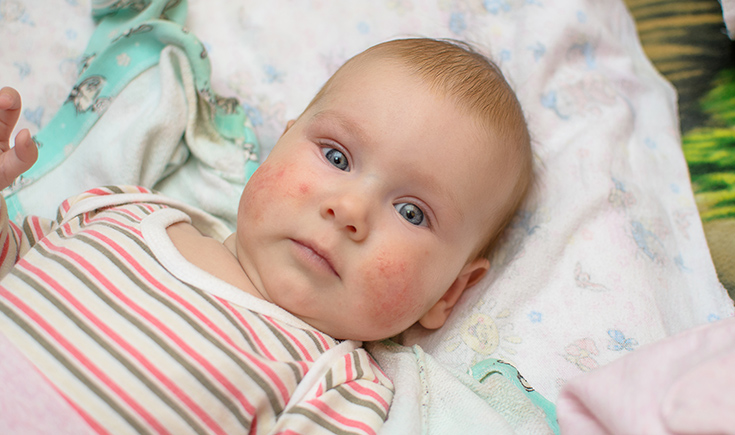

Eczema is a common condition with about 20 percent of children in industrialised nations suffering from eczema[i] [ii], while it appears that Australia is becoming the eczema capital of the world with almost 40 percent of babies in Australia suffering from eczema! It is thought that the interplay between human genes and the Australian environment is responsible for the high incidence of eczema here, with children born to East Asian parents at the highest risk of developing eczema in Australia. [iii]
Eczema tends to develop in early childhood, usually before the age of 6 months and is characterised by patches of dry, red, scaly skin, often extremely itchy. In babies, it primarily appears on the face and the outsides of the elbows and knees.

Babies who suffer from eczema typically have a skin barrier dysfunction which causes moisture to escape from the skin, resulting in skin dryness and cracking. The skin becomes more permeable and irritants and allergens can penetrate the skin which initiates inflammation in the skin.
Natural therapies aim to decrease the severity and frequency of eczema episodes, however, it is very important to seek medical help when your baby’s eczema is in the acute phase – when the skin is severely irritated.
Maintain and protect the skin barrier
Moisturise, moisturise and moisturise!
The single most important thing you can do for your baby with dry and eczema-prone skin is to keep their skin moisturised.
A randomised controlled trial have shown a 50% reduction in the risk of developing eczema in high-risk babies (with one parent or sibling having eczema, asthma or hayfever) when their whole bodies were moisturised once a day for the first 6 months of life.[iv]
For babies who already suffer from dry skin or eczema, it is advisable to moisturise their skin as frequently as possible (2-3 times per day) and always after a shower or bath. Parents often underestimate the amount of moisturiser needed for babies with dry or eczema-prone skin. Experts recommend using at least 250g of moisturiser per week on babies with eczema! [v]
Choose moisturisers that contain plant oils rich in precious fatty acids that will absorb into the deeper skin layers and soften and soothe skin such as sesame, sweet almond, borage, safflower or high-oleic sunflower oils. Add to that ingredients that can form a protective layer on top of the skin and slow down moisture escaping from the skin such as beeswax, coconut oil or cacao butter. Anti-inflammatory and soothing botanical extracts such as calendula, chamomile, marshmallow or pansy can also help to strengthen the skin’s natural functions and soothe the extreme itchiness that accompanies eczema and dry skin.
Avoid products that will dry out or irritate the skin
Soap and bubble baths damage and dry out the skin, with sodium lauryl sulphate (SLS) being one of the main culprits. Even natural fragrances can irritate eczema skin so it’s best to stick to fragrance-free products. Use soap-free baby washes or oils when bathing your baby to keep the skin barrier intact. And avoid baby wipes.
Avoid triggers
Although triggers are usually not the underlying cause of eczema, they can cause a flare-up and exacerbate symptoms. Below is a list of the most common triggers for babies with eczema. Take note that not all triggers need to be avoided, only the triggers that are relevant for your baby. If you are not sure what triggers your baby’s eczema, it could help to keep an eczema journal.
- Dry skin
- Scratching
- Viral or bacterial infections
- Temperature changes such as overly heated rooms
- Exposure to water, soap, perfumes or chemicals
- Swimming in chlorinated swimming pools
- Playing in sand and particularly sandpits
- Sitting directly on carpets or grass
- Woollen or synthetic fabrics
- Contact with pollen, mould, dust mites or animals
- Food intolerances and allergies
- Stress
Written By: By Liezel Barnard – Weleda Australia Naturopath
References
[i] Lewis-Jones S, Mugglestone MA. Management of atopic eczema in children aged up to 12 years: summary of NICE guidance. BMJ. 2007 Dec 15;335(7632):1263-4.
[ii] Innes Asher, M & Montefort, Stephen & Björkstén, Bengt & K W Lai, Christopher & P Strachan, David & K Weiland, Stephan & Williams, Hywel. Worldwide time trends in the prevalence of symptoms of asthma, allergic rhinoconjunctivitis and eczema in childhood: ISAAC Phases One and Three repeat multicountry cross-sectional survey. Lancet. 2006; 368. 733-43.
[iii] Martin, PE. The epidemiology of infantile eczema. PhD thesis, Medicine, Dentistry & Health Sciences – Paediatrics (RCH), The University of Melbourne. 2011.
[iv] Simpson EL, Chalmers JR, Hanifin JM, Thomas KS, Cork MJ, McLean WH. Emollient enhancement of the skin barrier from birth offers effective atopic dermatitis prevention. J Allergy Clin Immunol. 2014 Oct;134(4):818-23.
[v] Australasian Society of Clinical Immunology and Allergy (ASCIA). ASCIA Action Plan for Eczema. 2013.






















